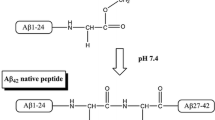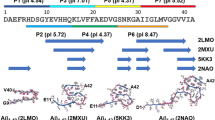Abstract
β-Amyloid peptide (Aβ) plays a key role in the pathogenesis of Alzheimer disease (AD). Monomeric Aβ undergoes aggregation, forming oligomers and fibrils, resulting in the deposition of plaques in the brain of AD patients. A widely used protocol for fibril formation in vitro is based on incubation of the peptide at low pH and ionic strength, which generates Aβ fibrils several microns long. What happens to such fibrils once they are brought to physiological pH and ionic strength for biological studies is not fully understood. In this investigation, we show that these changes strongly affect the morphology of fibrils, causing their fragmentation into smaller ones followed by their aggregation into disordered structures. We show that an increase in pH is responsible for fibril fragmentation, while increased ionic strength is responsible for the aggregation of fibril fragments. This behavior was confirmed on different batches of peptide either produced by the same company or of different origin. Similar aggregates of short fibrils are obtained when monomeric peptide is incubated under physiological conditions of pH and ionic strength, suggesting that fibril morphology is independent of the fibrillation protocol but depends on the final chemical environment. This was also confirmed by experiments with cell cultures showing that the toxicity of fibrils with different initial morphology is the same after addition to the medium. This information is of fundamental importance when Aβ fibrils are prepared in vitro at acidic pH and then diluted into physiological buffer for biological investigations.








Similar content being viewed by others
References
Ahmad A, Muzaffar M, Ingram VM (2009) Ca2+, within the physiological concentrations, selectively accelerates Aβ42 fibril formation and not Aβ40 in vitro. Biochim Biophys Acta 1794:1537–1548
Antzutkin ON (2004) Amyloidosis of Alzheimer’s Aβ peptides: solid-state nuclear magnetic resonance, electron paramagnetic resonance, transmission electron microscopy, scanning transmission electron microscopy and atomic force microscopy studies. Magn Reson Chem 42:231–246
Arimon M, Díez-Pérez I, Kogan MJ, Durany N, Giralt E et al (2005) Fine structure study of Aβ1-42 fibrillogenesis with atomic force microscopy. FASEB J 19:1344–1346
Bravo R, Arimon M, Valle-Delgado JJ, García R, Durany N et al (2008) Sulfated polysaccharides promote the assembly of amyloid β1-42 peptide into stable fibrils of reduced cytotoxicity. J Biol Chem 283:32471–32483
Bulbarelli A, Lonati E, Cazzaniga E, Gregori M, Masserini M (2009a) Pin1 affects Tau phosphorylation in response to Aβ oligomers. Mol Cell Neurosci 42:75–80
Bulbarelli A, Lonati E, Cazzaniga E, Re F, Sesana S, Barisani D, Sancini G, Mutoh T, Masserini M (2009b) TrkA pathway activation induced by amyloid-beta (Abeta). Mol Cell Neurosci 40:365–373
Carrotta R, Manno M, Bulone D, Martorana V, San Biagio PL (2005) Protofibril formation of amyloid β-protein at Low pH via a non-cooperative elongation mechanism. J Biol Chem 280:30001–30008
Cazzaniga E, Bulbarelli A, Cassetti A, Lonati E, Re F, Palestini P, Mutoh T, Masserini M (2007) β-Amyloid (25–35) enhances lipid metabolism and protein ubiquitination in cultured neurons. J Neurosci Res 85:2253–2261
Chafekar SM, Hoozemans JJ, Zwart R, Baas F, Scheper W (2007) Abeta 1-42 induces mild endoplasmic reticulum stress in an aggregation state-dependent manner. Antioxid Redox Signal 9:2245–2254
Chen S-H, Chu B, Nossal R (1981) Scattering techniques applied to supramolecular and non equilibrium systems. Plenum, New York
Choucair A, Chakrapani M, Chakravarthy B, Katsaras J, Johnston LJ (2007) Preferential accumulation of Aβ (1-42) on gel phase domains of lipid bilayers: an AFM and fluorescence study. Biochim Biophys Acta 1768:146–154
Chromy BA, Nowak RJ, Lambert MP, Viola KL, Chang L et al (2003) Self-Assembly of Aβ1-42 into globular neurotoxins. Biochemistry 42:12749–12760
Dahlgren KN, Manelli AM, Stine WB Jr, Baker LK, Krafft GA, LaDu MJ (2002) Oligomeric and fibrillar species of amyloid-β peptides differentially affect neuronal viability. J Biol Chem 277:32046–32053
Findeis MA (2007) The role of amyloid β peptide 42 in Alzheimer’s disease. Pharmacol Therapeut 116:266–286
Harnau L, Winkler RG, Reineker P (1996) Dynamic structure factor of semiflexible macromolecules in dilute solution. J Chem Phys 104:6355–6368
Harper JD, Wong SS, Lieber CM, Lansbury PT Jr (1997) Observation of metastable Aβ amyloid protofibrils by atomic force microscopy. Chem Biol 4:119–125
Hill SE, Robinson J, Matthews G, Muschol M (2009) Amyloid protofibrils of lysozyme nucleate and grow via oligomer fusion. Biophys J 96:3781–3790
Irvine GB, El-Agnaf OM, Shankar GM, Walsh DM (2008) Protein aggregation in the brain: the molecular basis for Alzheimer’s and Parkinson’s diseases. Mol Med 14:451–464
Jarrett JT, Berger EP, Lansbury PT Jr (1993) The carboxy terminus of the amyloid protein is critical for the seeding of amyloid formation: implications for the pathogenesis of Alzheimer’s disease. Biochemistry 32:4693–4697
Klein WL (2002) Aβ toxicity in Alzheimer’s disease: globular oligomers (ADDLs) as new vaccine and drug targets. Neurochem Int 41:345–352
Koo EH, Lansbury PT Jr, Kelly JW (1999) Amyloid diseases: abnormal protein aggregation in neurodegeneration. Proc Natl Acad Sci USA 96:9989–9990
Kusumoto Y, Lomakin A, Teplow DB, Benedek GB (1998) Temperature dependence of amyloid β-protein fibrillization. Proc Natl Acad Sci USA 95:12277–12282
LaFerla FM, Green KN, Oddo S (2007) Intracellular amyloid- in Alzheimer’s disease. Nat Rev Neurosci 8:499–509
Lee S, Fernandez EJ, Good TA (2007) Role of aggregation conditions in structure, stability, and toxicity of intermediates in the Aβ fibril formation pathway. Protein Sci 16:723–732
Lin M-S, Chiu H-M, Fan F-J, Tsai H-T, Wang SS-S et al (2007) Kinetics and enthalpy measurements of interaction between β-amyloid and liposomes by surface plasmon resonance and isothermal titration microcalorimetry. Colloid Surface B 58:231–236
Liu R, Barkhordarian H, Emadi S, Park CB, Sierks MR (2005) Trehalose differentially inhibits aggregation and neurotoxicity of beta-amyloid 40 and 42. Neurobiol Dis 20:74–81
Lomakin A, Chung DS, Benedek GB, Kirschner DA, Teplow DB (1996) On the nucleation and growth of amyloid β-protein fibrils: detection of nuclei and quantitation of rate constants. Proc Natl Acad Sci USA 93:1125–1129
Lomakin A, Teplow DB, Kirschner DA, Benedek GB (1997) Kinetic theory of fibrillogenesis of amyloid β-protein. Proc Natl Acad Sci USA 94:7942–7947
Lorenzo A, Yankner BA (1994) β-Amyloid neurotoxicity requires fibril formation and is inhibited by Congo red. Proc Natl Acad Sci USA 91:12243–12247
Luhrs T, Ritter C, Adrian M, Riek-Loher D, Bohrmann B et al (2005) 3D structure of Alzheimer’s amyloid-beta (1-42) fibrils. Proc Natl Acad Sci USA 102:17342–17347
Makin OS, Serpell LC (2005) Structures for amyloid fibrils. FEBS J 272:5950–5961
Manzoni C, Colombo L, Messa M, Cagnotto A, Cantù A, Del Favero E, Salmona M (2009) Overcoming synthetic Aβ peptide aging: a new approach to an age-old problem. Amyloid 16:71–80
Moretto N, Bolchi A, Rivetti C, Imbimbo BP, Villetti G et al (2007) Conformation-sensitive antibodies against Alzheimer amyloid-β by immunization with a thioredoxin-constrained B-cell epitope peptide. J Biol Chem 282:11436–11445
Olsen SN, Andersen KB, Randolph TW, Carpenter JF, Westh P (2009) Role of electrostatic repulsion on colloidal stability of Bacillus halmapalus alpha-amylase. Biochim Biophys Acta 1794:1058–1065
Parbhu A, Lin H, Thimm J, Lal R (2002) Imaging real-time aggregation of amyloid β protein (1-42) by atomic force microscopy. Peptides 23:1265–1270
Patel D, Henry J, Good T (2006) Attenuation of β-amyloid induced toxicity by sialic acid-conjugated dendrimeric polymers. Biochim Biophys Acta 1760:1802–1809
Pecora R (1985) Dynamic light scattering: application of photon correlation spectroscopy. Plenum, New York
Petkova AT, Leapman RD, Guo Z, Yau WM, Mattson MP, Tycko R (2005) Self-propagating, molecular-level polymorphism in Alzheimer’s β-amyloid fibrils. Science 307:262–265
Russel WB, Saville DA, Showalter WR (1989) Colloidal dispersion. Cambridge University Press, Cambridge
Sahoo B, Nag S, Sengupta P, Maiti S (2009) On the stability of the soluble amyloid aggregates. Biophys J 97:1454–1460
Selkoe DJ (1999) Translating cell biology into therapeutic advances in Alzheimer’s disease. Nature 399:A23–A31
Selkoe DJ (2004) Cell biology of protein misfolding: the examples of Alzheimer’s and Parkinson’s diseases. Nat Cell Biol 6:1054–1061
Shen C-L, Murphy RM (1995) Solvent effects on self-assembly of beta-amyloid peptide. Biophys J 69:640–651
Sicorello A, Torrassa S, Soldi G, Gianni S, Travaglini-Allocatelli C, Taddei N, Relini A, Chiti F (2009) Agitation and high ionic strength induce amyloidogenesis of a folded PDZ domain in native conditions. Biophys J 96:2289–2298
Stine BW Jr, Dahlgren KN, Krafft GA, LaDu MJ (2003) In vitro characterization of conditions for Amyloid-β Peptide oligomerization and fibrillogenesis. J Biol Chem 278:11612–11622
Tabner BJ, Turnbull S, El-Agnaf OMA, Allsop D (2001) Production of reactive oxygen species from aggregating proteins implicated in Alzheimer’s Disease, Parkinson’s Disease and other neurodegenerative diseases. Curr Top Med Chem 1:507–517
Talmard C, Bouzan A, Faller P (2007) Zinc binding to amyloid-β: isothermal titration calorimetry and Zn competition experiments with Zn sensors. Biochemistry 46:13658–13666
Taylor M, Moore S, Mayes J, Parkin E, Beeg M, Canovi M, Gobbi M, Mann DMA, Allsop D (2010) Development of a proteolytically stable retro-inverso peptide inhibitor of β-amyloid oligomerization as a potential novel treatment for Alzheimer’s disease. Biochemistry 49:3261–3272
Weldon DT, Rogers SD, Ghilardi JR, Finke MP, Cleary JP, O’Hare E et al (1998) Fibrillar β-amyloid induces microglial phagocytosis, expression of inducible nitric oxide synthase, and loss of a select population of neurons in the rat CNS in vivo. J Neurosci 18:2161–2173
Yagi H, Ban T, Morigaki K, Naiki H, Goto Y (2007) Visualization and classification of amyloid β supramolecular assemblies. Biochemistry 46:15009–15017
Yan P, Hu X, Song H, Yin K, Bateman RJ et al (2006) Matrix metalloproteinase-9 degrades amyloid-β fibrils in vitro and compact plaques in situ. J Biol Chem 281:24566–24574
Yang Y-L, Kaufman LJ (2009) Rheology and confocal reflectance microscopy as probes of mechanical properties and structure during collagen and collagen/hyaluronan self-assembly. Biophys J 96:1566–1585
Zagorski MG, Yang J, Shao H, Ma K, Zeng HN, Hong A (1999) Methodological and chemical factors affecting amyloid β peptide amyloidogenicity. Method Enzymol 309:189–204
Zako T, Sakono M, Hashimoto N, Ihara M, Maeda M (2009) Bovine insulin filaments induced by reducing disulfide bonds show a different morphology, secondary structure, and cell toxicity from intact insulin amyloid fibrils. Biophys J 96:3331–3340
Acknowledgments
The research leading to these results has received funding from the European Community’s Seventh Framework Programme (FP7/2007–2013) under grant agreement no 212043.
Author information
Authors and Affiliations
Corresponding author
Additional information
M. Gregori and V. Cassina contributed equally to this work.
Rights and permissions
About this article
Cite this article
Gregori, M., Cassina, V., Brogioli, D. et al. Stability of Aβ (1-42) peptide fibrils as consequence of environmental modifications. Eur Biophys J 39, 1613–1623 (2010). https://doi.org/10.1007/s00249-010-0619-6
Received:
Revised:
Accepted:
Published:
Issue Date:
DOI: https://doi.org/10.1007/s00249-010-0619-6




